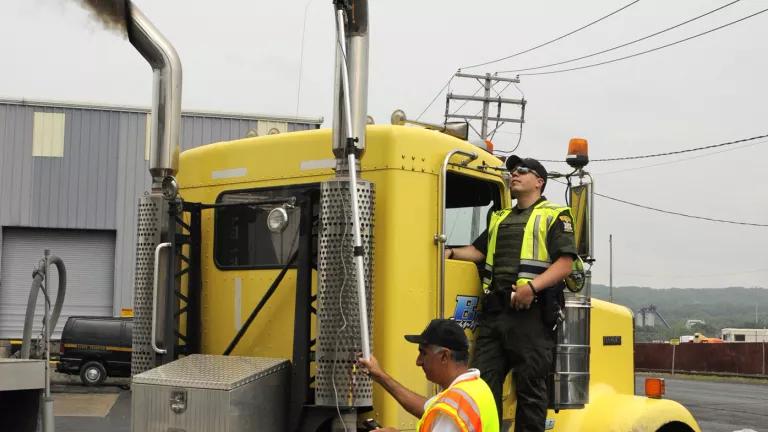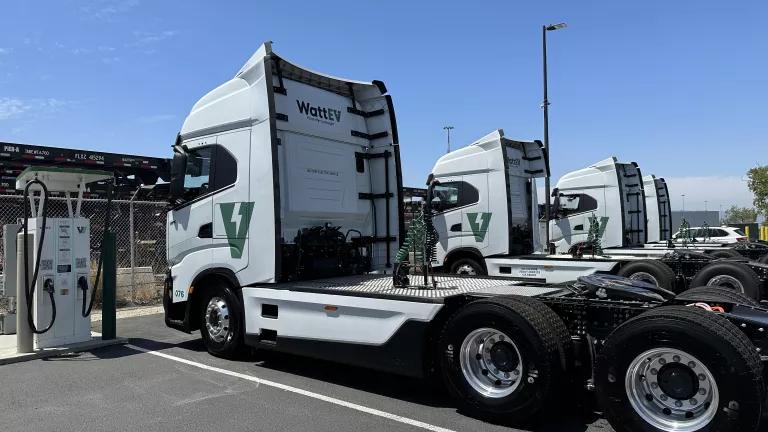Truck Manufacturers Sue to Continue Polluting
The Truck and Engine Manufacturers Association and their members file a hypocritical and self-defeating lawsuit to delay a lifesaving California clean truck regulation.

NYS DEC, HDDV Heavy Duty Diesel Vehicle emissions inspection DLE EJ community Air Pollution prevention Port of Albany.
NOTE (07/02/2022): This blog has been updated to reflect recent statements by Ford, GM, and Cummins clarifying that, although they are EMA members, they do not support this lawsuit.
On the Friday before Memorial Day weekend the Truck and Engine Manufacturers Association (EMA) and their member companies filed a lawsuit to delay a lifesaving California clean truck regulation: the Heavy-Duty Omnibus (HDO) rule.
The HDO rule dramatically cuts air pollution from new diesel vehicles by reducing allowable oxides of nitrogen (NOx) emissions from heavy-duty trucks by roughly 75% below current standards beginning in 2024 and 90% in 2027. NOx emissions are dangerous to public health by themselves and as precursors to ground-level ozone, or smog. In addition to cleaning up NOx, the HDO rule looks to institutionalize fine particulate matter (soot) pollution controls and prevent backsliding. These reductions add up to $36 billion in California-wide health benefits from 3,900 avoided premature deaths and 3,150 hospitalizations by 2050.
The lawsuit filed by EMA claims the California Air Resources Board’s (CARB) adoption of the HDO regulation failed to comply with a provision of the federal Clean Air Act (CAA) that requires a four-year lead-time for implementing emissions standards on new trucks, despite the fact that California has consistently adopted heavy-duty truck engine standards under its federal Clean Air Act waiver authority that have never been subject to the four-year lead time provision of the CAA.
The lawsuit fits into a larger trend where EMA attempts to opposed and delay critical clean truck emission standards. For example, EMA has vigorously fought the adoption of the Advanced Clean Trucks (ACT) rule in CA and other states which would slash harmful air pollution by requiring manufacturers to sell an increasing number of medium- and heavy-duty (MHD) zero-emission vehicles (ZEVs).
Because of the overwhelming public health, environmental, and economic benefits from the HDO and ACT rules, six states adopted the ACT rule, three adopted the HDO rule, and more are in the process of doing so this year and next.
Importantly, these rules target air pollution emissions that disproportionately harm frontline communities living in and around transportation infrastructure such as ports, warehouses, and freeways. And these communities are predominantly communities of color and low-income.
Hypocrisy or ignorance? Neither is an excuse.
EMA’s lawsuit is a direct attack on our communities, lungs, and the environment. It’s also a new low for EMA, a trade association comprised of vehicle and engine manufactures who have made public statements about their desire to clean up vehicle pollution. A full list can be found here, but some highlights from the most influential members are below.
"We create tomorrow. A tomorrow that's cleaner, that's healthier, that's safer, and smarter. A tomorrow we all want to see. A tomorrow we all want our children and their children to see. … We don't build trucks. We move the world." —John O’Leary, President & CEO, Daimler Truck North America
“Volvo Trucks is committed to lead the commercial transport industry towards more sustainable solutions by advancing electromobility. We will continue to invest in and drive the development of this technology, both globally and right here in North America.” —Peter Voorhoeve, President, Volvo Trucks North America
“Protecting the environment is the biggest challenge we face. With new technologies, increased social momentum and industry collaboration, we can turn this challenge into our greatest achievement.” —Lars Martensson, Director Environment and Innovation, Volvo Trucks
“Stellantis will be the industry champion in climate change mitigation, becoming carbon net zero by 2038, with a 50% reduction by 2030. Taking a leadership role in decarbonization, as well as a decisive step forward in the circular economy, is our contribution to a sustainable future.” —Carlos Tavares, CEO, Stellantis
Do they know that EMA is fighting on their behalf to undermine the future they profess to seek? If so, they should be ashamed. If not, these companies should make the EMA drop the lawsuit.
A self-defeating lawsuit that will harm manufacturers.
The lawsuit is also self-defeating if the truck engine manufacturers really want to clean up their act – because adoption of these foundational emission standards is unlocking additional policies and resources to help transition to zero-emission vehicles.
In addition to the millions of public dollars California allocates to help manufacturers sell their vehicles, the California Air Resources Board (CARB)—the agency EMA is currently suing—is developing a new standard called the Advanced Clean Fleets (ACF) rule that would require certain fleets to buy an increasing number of ZEVs. The ACF rule is a demand-side regulation that directly benefits manufacturers’ bottom lines. In addition, in other states that adopted the rules, such as New Jersey, having a clear regulatory schedule is unlocking additional medium and heavy-duty vehicle charging infrastructure that will directly help manufacturers sell their products.
States should continue to press for maximum transportation pollution reductions.
This lawsuit is evidence that no matter the public statements, truck manufacturers will never clean up their act unless forced to by vehicle emission standards. For states that want to zero-out truck pollution to protect public health and the environment, adopting the ACT and HDO rules remain the best ways to do so.



